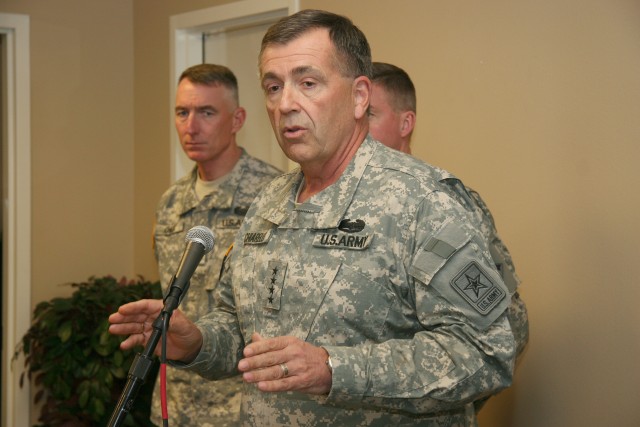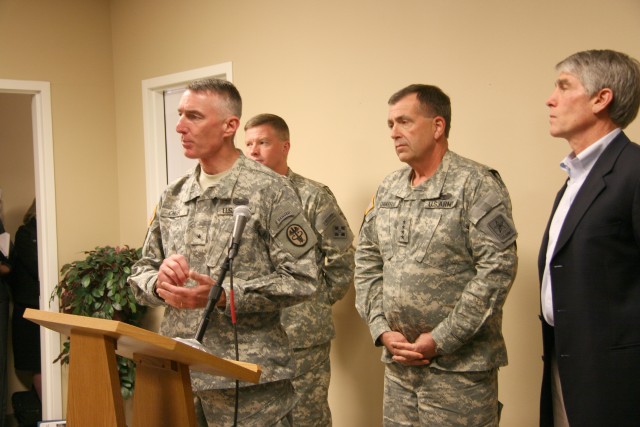FORT CARSON, Colo. (May 6, 2010) -- The Army's vice chief of staff, the commander of the Warrior Transition Command and three congressmen visited Fort Carson's Warrior Transition Unit May 3.
Gen. Peter W. Chiarelli, Brig. Gen. Gary Cheek, Sen. Mark Udall and Rep. Doug Lamborn from Colorado and Rep. Norm Dicks from Washington met with WTU leadership and Soldiers before holding a press conference for local and regional media at the Soldier and Family Assistance Center.
In a statement to the press, Udall acknowledged "the great strides the Army has made over the last couple years as it provides care for our Soldiers, especially those Soldiers who are suffering from PTSD (post-traumatic stress disorder) or TBI (traumatic brain injury). I've seen it firsthand. These are Soldiers who have significant medical challenges, and we're going to continue to learn how to best care for them."
He added that he wanted to be sure the Army had all of the resources it needed to care for wounded warriors and addressed an already-planned inspector general visit set for mid-May and called for Fort Carson to join other installations in a pilot program that allows Soldiers to seek help for alcohol abuse without notifying their leadership.
The Army Inspector Gerneral is currently visiting other WTUs across the Army to inspect the processes within the units, Chiarelli said.
He said that tools such as IG inspections and surveys help the Army continue to look at and revise the way it treats its war-wounded Soldiers.
"We're doing our best to learn, and we will continue to learn and see if we've got these issues in other locations," Chiarelli said. "These are very complicated cases, and I will tell you, if you look across (the Army) - and we do this every single month - 82 percent of the Soldiers who go through our WTUs indicate they have a positive experience.
"We're going to try our darnedest to get better than that, but I don't think we'll ever get up to 100 percent, because of the complexity of the cases we are talking about here."
Three former and current wounded warriors spoke at the press conference to relay their experiences in the WTU, including Sgt. Jerrald Jensen, 3rd Squadron, 61st Cavalry Regiment, 4th Brigade Combat Team, 4th Infantry Division.
"(I wanted to) put a little more positive light on the experience I had here at the WTU," Jensen said. "If it wasn't for them, I would not have been able to return to duty, which was my ultimate goal."
Jensen was seriously injured by a roadside bomb while deployed to Iraq in 2007.
"I spent 2 1/2 years recovering (in the WTU) and made this last deployment with my unit. I'm proud to serve, and I'll continue to serve as long as my body will allow me," Jensen said.
Chiarelli said one purpose of his visit was to thank the leadership and cadre of Fort Carson's WTU.
"I happen to believe that this is one of our top WTUs. They've worked very, very hard. They've got an absolutely outstanding command team out here," he said. "I just wanted to talk to them, tell them they have all my confidence in the world."




Social Sharing